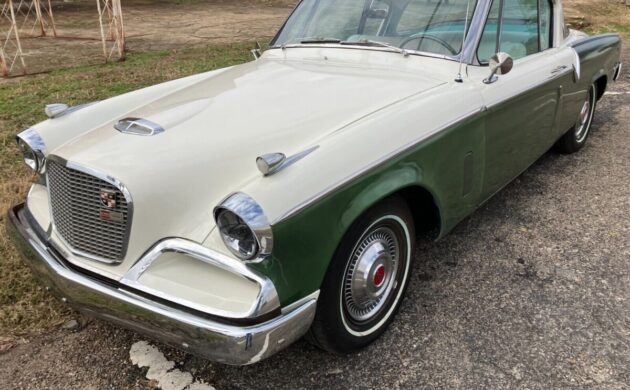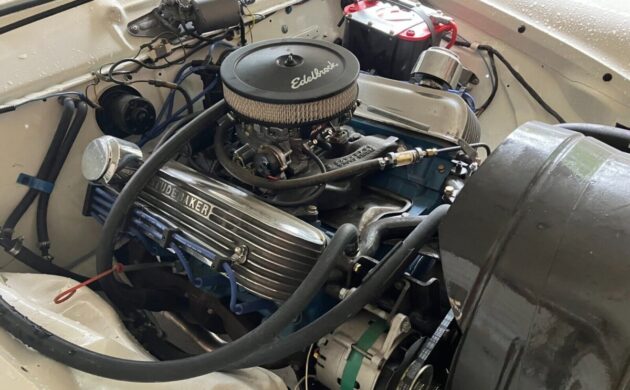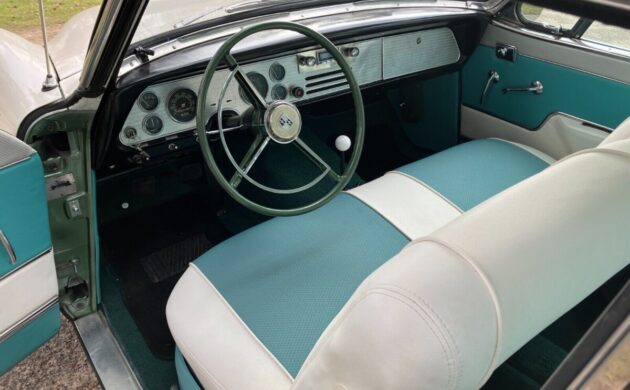Between 1956 and 1964, there were no less than eight variants of the Hawk series, including one short-lived example badged as a Packard. The Sky Hawk was a one-year-only edition (1956), a 2-door pillarless hardtop that resembled the Golden Hawk but without the fins or a Packard motor. This nice example had a recent frame-off partial restoration that focused on the underpinnings of the car. Also, it may have an Avanti motor from 1963-64. Located in Emory, Texas, this sweet ride is available here on eBay where the current bid is $7,000, the reserve is still looming, but the pass-go price is $19,900.
For 1956, designer Raymond Loewy repackaged the Starliner coupe and came up with the Hawk, a nameplate that would survive until Studebaker quit making automobiles in the U.S. The Sky Hawk was one of four Hawks offered in 1956, sharing its core body with the more upscale Golden Hawk. But the Sky Hawk was given less trim to keep the price lower and the cars used the Studebaker President’s 289 cubic-inch V8 instead of the 352 Packard motor in the 1956 Goldens (they would go with a supercharged 289 in the Golden Hawk in 1957). Only 3,050 Sky Hawks were built in its single outing, so they don’t turn up too often these days.
The seller makes a point of saying this car sports an Avanti R-1 V8, which was also 289 cubic inches. To me, that’s another way of saying the original engine was replaced at some point, and possibly the transmission which is a rebuilt Borg-Warner T-10 4-speed manual. The powerplant in the car was rebuilt, too, and has only seen 3,500 miles. Some upgrades were made in the process, such as with the distributor, alternator, headers, and dual exhaust system.
When the body was removed, the seller (we assume) did some minor repairs underneath, and pressure-washed everything plus applied some epoxy paint and sound-deadening materials. As a result, the car has a much quieter ride than it would have had in 1956. Most of the gauges and instruments work fine (the speedo and tach are from an Avanti), and a retro Bluetooth radio has been added. The only downside, if there is one, is that the paint is older and has a few blemishes. But from the photos provided, you’ll have to look for them.






I like it, I suppose the purist Studebaker collector will cringe. The modifications seem to be using Studebaker parts, yeah newer engine and that was probably a three speed car. Headlights and the headliner changed out as the dash is using different gauges, but all put together it looks good. I suppose those are backup lamps on the rear pan, small and the green paint looks off in spots but overall nicely done.
The speedo and tach are factory Studebaker from the 1963-64 cars – the other are most likely new units.
What a design for 1956- years ahead of the other big car companies. The Volvo P1800 took a lot of ideas from this car.
The best looking Hawk of the bunch. All downhill from here. My ’53 keeps looking better every time I see these later cars.
Studebaker sure made some beautiful cars, way ahead of their time, and go down as as classics of all time !
Beautiful looking Studebaker. I’ve always loved Studebaker Hawks up to the 1962 model year.
Hardtop, just “hardtop”. Not “pillarless” hardtop.
By definition a hardtop is…… pillarless.
That definition was established over 70 years ago.
Yea, some whippersnappers don’t get the lexicon of old. “Hardtop” means no center (or “B”) pillars, whereas “sedan” is basically a hardtop with “B” pillars. I can kind of see why they can’t get it, as no true hardtops were sold in America after 1974; you know, Nader and all that. Not even 2-door cars were built without B-pillars, except for ‘verts.
Tony,
GM did build several “two door hardtop” cars in the Tornado, Riviera, and Eldorado bodies from 1979 through 1985 model years. Those were some very good looking body styles, in my opinion. You are right about the full size, and even the mid-sized Chevy, Pontiac, Buick, and Oldsmobile hardtop bodies being discontinued by 1973.
a true hardtop means when you roll the windows down, you see nothing but empty space where the b-pillar would be.
Am I the only one who thinks the color combo a bit weird? Dark green exterior and a blue-ish interior. No bueno.
Maybe, but not really for 1956. Three-tone clashes were part of the then-vogue, especially clashes of loud colors that don’t exist in nature. 😄 It could be a mistake of the owner during restoration, but people who go by the perception of the ’50s probably wouldn’t notice. I mean, I retrofitted head rests into my ’66 Lincoln’s front seats, using parts from a ’69. To this day, nobody has even noticed (there was no such thing as a head rest in ’66, except maybe in racing cars).
The ad states that the engine is rebuilt with R3 headers.
Did Studebaker have their own 289 or was it a Ford?
Its a Stude engine , both companies had 289 V8s
Homer,
It’s a Studebaker engine, introduced as a smaller 259[?] in 1951.
232 cid
Poppy,
Thanks, I had a brain fart and couldn’t remember the original size.
The Ford 289 didn’t come out until 64. Studebaker had theirs in 56.
It’s a Studebaker engine
Nice car, just a little pricey.
Of all the Studebaker Hawks I’ve had over the last 50 years, my 1956 Sky Hawk was one of my favorites. All original, with 54,000 miles, 289 engine, dual exhaust, 4-barrel carb, “Twin-Traction” diff [posi] and 3 speed & OD.
studebakers were not known for there color matching…only they would put blue in a green car. you would think green inside would be there but every stud. i have seen most did not have good color matching of inside and outside colors. but when they did get it right they were very good matches. it is like they were being cheap and any color they could get they used. they used black and white inside on almost any color car. i have seen pink inside when car has no pink. stud used a lot of pink on there outside colors.
I’m wondering if that contributed to their demise, that degree of carelessness when matching colors. It would help explain why they were so quick to merge with Packard, which for all its own problems was still the stronger of the two when they merged. So ironic that Packard would cease to exist first.
I wish Studebaker had carried the dash from the ’55 over. It was beautiful, with the machine rolled finish. This isn’t bad however, and Studebaker always had nice dashes all the way to the end.
1951 first year for the 232 V8. They grew from here.